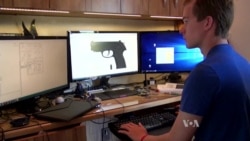The United States has the highest civilian firearm ownership rate in the world, and a recent study ranked it in the top tier of countries in public mass shooters per capita. In fact, in the first 204 days of this year, there were 204 mass shootings in the United States - attacks in which four or more people were killed or injured.
Only a handful of those attacks make national headlines. One of the most horrific was three years ago, when a gunman opened fire at a Colorado movie theater, killing 12 people, and injuring 70 others.
Kai Kloepfer was a 15-year-old high school sophomore in the nearby community of Boulder, Colorado, at the time of the shooting. He had a talent for technology, and had been taking apart video machines and teaching himself engineering since the age of five. He decided to focus his engineering skills on preventing firearm tragedies.
"I kind of set out to improve the safety of firearms,” he recalled.
A safer gun
Kloepfer wanted to make a gun that wouldn't work in the hands of a killer. While he believed he could design that gun, he also realized it would be impossible to keep dangerous people from buying guns. So he changed his focus, recognizing there were other gun-related tragedies he could do something about - accidental shootings, when children get their hands on a family gun and kill a friend or themselves while playing with it.
“Every 30 minutes in the United States, a child dies or is injured by a firearm," Kloepfer pointed out. "Add up a child every 30 minutes over even, say a week, and you have an astronomically larger number of people than has ever been injured in any type of mass shooting in the United States.”
Those numbers come from a study done by the Children's Defense Fund. A more recent study by the American Academy of Pediatrics found that at least 10,000 kids or teens are killed or injured by guns every year.
Kloepfer decided the gun he would design would be a safer weapon. It would fire only when unlocked by the fingerprint of the owner or an authorized user, not for anyone else.
A winning design
It took seven months and over 1,500 hours for Kloepfer to create a plastic, "smart gun" prototype. He entered his fingerprint handgun in the local science fair - where he won . . . and kept winning, all the way to the world’s top youth science competition. At the age of 16, he won the INTEL International Science and Engineering Fair.
“7.4 million people across the world compete at some level of that," he said. "But only 1,500 people each year get to attend the Intel Science Fair. I was amazingly selected by the judges to attend the Intel Science Fair and actually ended up winning the first place grand award in engineering for that year.”
The INTEL award included a small cash prize. Kloepfer applied for a grant from the SmartTech Challenges Foundation, whose mission is to foster innovation in firearm safety. He received $50,000.
Now 18, Kloepfer has been using the grant money to further develop his technology and continue to refine his prototype.
“This doesn’t change the function of a firearm at all. It just makes it safer,” he said. He is now integrating the fingerprint lock technology into a live metal gun, and expects to one day see his smart gun for sale side-by-side with regular firearms.
Constantly seeking feedback, Kloepfer showed the plastic prototype to Kye Javes, a deputy with the Boulder County Sheriff's Office, who peppered the teenager with questions about its durability and reliability. He noted that a safer gun will never be a substitute for proper training, but could make a difference in a far too common situation.
“I know a lot of people leave a gun on a nightstand, because they want to have accessibility to it," he said. "To me, this is the answer to that.”
And Javes had a request for the young inventor: “When you get a working prototype, I would love to shoot it!”
Kai Kloepfer plans to spend the next year focusing on refining his fingerprint handgun. Then he’ll start classes at one of the world’s top science schools - the Massachusetts Institute of Technology.






